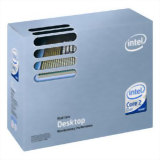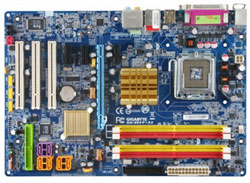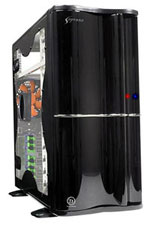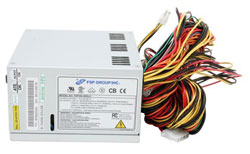Upgraded Intel Midrange Platform
If we had to choose one system as an overall recommendation today, it would have to be this upgraded Core 2 Duo configuration. There are almost no compromises made, and without spending significantly more money it will be difficult to improve performance. As usual, the one exception is gaming, where a faster, more expensive GPU is almost always a possibility. Below is our upgraded Intel recommendation.
 |
As with the AMD platform, our upgraded Intel system has moved up one rung on the performance ladder. Moving from the E6300 to the E6400 represents a 14% CPU speed increase, and it comes with a 23% price increase. Bang for the buck is actually better than the AMD upgrade, but there are other advantages as well. The base clock speed is now 2.13 GHz with an 8X multiplier. Clock speeds of beyond 3 GHz should now be achievable, with a 400 MHz front side bus equating to a 3.2 GHz CPU. Even without overclocking, the E6400 is no slouch, generally offering performance that falls somewhere between that of the Athlon X2 4600+ and 5000+. With overclocking, the E6400 at 3.0 GHz appears to be out of reach of anything AMD can offer with their current architecture and process technology, all at a price of about $225.
You could upgrade to 4MB of cache and 2.4 GHz for another $90 if you so desire, and there are various reasons to do so. The increased clock speed will improve performance about 12%, and the larger L2 cache will on average add another 5% to performance - assuming nothing else is your bottleneck - for a total speed increase of about 18%. The price increase is 41% however, so you are essentially getting 1-for-2 performance scaling. If you are more concerned with CPU performance, the E6600 is a nice upgrade; for gamers you would be much better off spending the money on a faster GPU.
 |
For the upgraded configuration, we still couldn't go with a super high-end motherboard, but we did upgrade to a motherboard that should offer some great overclocking potential. The Gigabyte GA-965P-S3 first showed up in our labs as a pretty mediocre offering, but with the latest BIOS updates it has turned into a real gem. The Gigabyte DS3 will still overclock a bit better in terms of maximum bus speed, but you're much more likely to run into the limitations of your memory and/or processor first. 400 MHz bus speeds are easily achievable on the S3, and a 3.2 GHz Core 2 Duo processor is extremely fast. Note that you do only get a single X16 graphics slot, so if you want more gaming performance you will have to resort to something like the 7950 GX2 cards or wait for faster models to arrive on the market.
Again, we've already looked at the memory and video card options with the upgraded AMD configuration, so let's move on to the storage and other components. We stuck with the NEC ND-3550A DVD-RW drive for all of the reasons we listed previously and we also kept the same mouse, keyboard, and operating system to keep things simple. On the hard drive, we make the upgrade to a slightly larger 320GB model that supports 16MB of cache and comes with a five year warranty from Seagate. Western Digital, Samsung, Maxtor, and Hitachi are again competitive with slightly varying features and performance.
 |
Where we made a big change over the baseline configuration is the choice of case and power supply. Opinions on cases are going to vary widely from person to person. What one person thinks looks awesome another person is going to think looks garish; slick and sleek for us might be dull and boring for you. The Thermaltake Soprano is a nice looking case, at least in our opinion, and you get two 120mm fans that provide a good amount of air flow without creating a ton of noise. The case also features a mostly tool-less design, and you can get it with or without a side window. If you don't like the case that we picked, by all means go out and select a case that you do like. Sticking with the baseline case is certainly an option to save money, although the power supply is a different matter.
 |
While we still haven't created a configuration that really needs an extremely high-end power supply, if you are going to spend money for a quality aftermarket power supply there's no reason to save $10-$15 and miss out on some features that might prove useful in the long run. Fotron Source is one of the most well-regarded power supply manufacturers, and several well-known power supply providers basically offer rebranded Fotron Source PSUs. We did have to draw the line somewhere, so you won't see is recommending $150+ power supplies for a midrange computer. We ended up settling on the 550W SLI ready FSP550-80GLC, which offers plenty of power, relatively silent operation, and it's ready for multiple graphics cards should you ever decide to take that step.
If you only intend to run a single GPU and you aren't going to overclock, many of our upgrade options could easily be changed. The RAM in particular was chosen to really allow some overclocking headroom, but you could stick with the cheaper RAM and instead simply buy a faster CPU. Getting a good quality PSU is rarely a bad decision, but for non-overclockers you can stick with a bundled PSU of around 400W and you shouldn't have problems. In the end, we are limited in the number of configurations we can list due to time constraints, but by all means feel free to ask or comment on the component choices, as there is no "one size fits all" computer system.














49 Comments
View All Comments
JarredWalton - Tuesday, October 3, 2006 - link
For a moderate system, I like PSU fan + front fan + rear fan (all 120mm if possible, with lower RPMs). More than two case fans gets to be overkill, and you could probably run a single 120mm rear case fan without problems.jonp - Thursday, September 28, 2006 - link
I think the E6400 base is 2.13GHz not 2.16Ghz.http://www.intel.com/products/processor/core2duo/s...">http://www.intel.com/products/processor/core2duo/s...
JarredWalton - Thursday, September 28, 2006 - link
It is. Did I mess that up somewhere? Ah: I had it right in the table but missed it in the text below. Sorry. It's been corrected now.jonp - Wednesday, September 27, 2006 - link
The MSI P965 Neo-F takes a beating by Newegg buyers:http://www.newegg.com/Product/Product.asp?Item=N82...">http://www.newegg.com/Product/Product.asp?Item=N82...
The trouble folks are having with the MB make me wonder
if the choice should be rethought? Or at least, if you're thinking
about it, read the experiences folks are having so you are
prepared make the choice work for you.
Jon
JarredWalton - Wednesday, September 27, 2006 - link
The original BIOS adhered directly to Intel's specs so memory not capable of 1.8V at boot or over DDR2-800 JEDEC had issues. (Of course this happened on just about all of the P965 boards! P965 at launch was a joke - just ask Gary Key.) MSI is still working on updating the BIOS, but the current version now works fine with DDR2-800 or below 1GB modules. You did note that the system recommendation included 2x1GB of DDR2-667, right?Anyway, this is a base P965 board, and it has limited overclocking and other capabilities. Anyone buying it thinking they are going to get an awesome OC is nuts, and that's likely where the negative comments on Newegg come from. Buying higher-end RAM and putting it in a lower-end motherboard often results in problems. I have a lot of motherboards that won't POST at all with some OCZ DDR2-800 RAM that wan'ts 2.2V for 3-3-3 timings, or 1.8V for 5-5-5 timings.
How far can the MSI P965 go? I believe the current BIOS limit is 350 MHz, with 325-333 being a reasonable target. Set your RAM for DDR2-533 and the FSB for 333 MHz, and you shouldn't have issues (provided the CPU can handle the OC - and almost every 2MB Core 2 Duo should do that OC without problems).
As I mentioned above, anyone can get on the internet and post a "review". We have no idea if they're really experienced or just complete noobs, and you certainly get what you pay for to an extent. It's a good baseline motherboard, but it won't set any performance records. We tried to keep the budget as close to $1000 as possible, so every $25 increase becomes significant.
jonp - Thursday, September 28, 2006 - link
As an alternative I would like to consider the Asus P5LD2, ver 2.01g which supports Core 2 Duo.Memory: DDR2-667 and 4GB -- this fits midrange to me
PCIe: 1 extra
PATA: 4 additional ATA100 *** especially good for those of us still in transition
SATA 3GB: 4 instead of 5
SATA RAID: included
Albeit not the Deluxe version from the http://www.anandtech.com/showdoc.aspx?i=2753&p...">Pre-AM2 Mid-Range Buyers Guide, May 2006 but a more mature solution (than the MSI) with features that help make the Core 2 Duo/SATA transition and it's almost the same price.
JarredWalton - Thursday, September 28, 2006 - link
The MSI board fully supports up to 8GB of RAM as long as it's DDR2-667 or lower. (Officially at least - it should now run 4x1GB DDR2-800, though perhaps not at super-tight timings.) About the only advantage of the ASUS 945P P5LD2 R2.0 is that it has more IDE ports. The MSI board has FireWire. Which is more important? That's up to the individual - for HTPC use FireWire is great, but not too much else for the majority of users. I can make a similar argument about IDE support.The Buyer's Guides are written targeting new PC builds rather than as a specific upgrade recommendation. It could be that the ASUS is a better upgrade option for those that have IDE hard drives they want to keep. In most areas I wouldn't call it "better" than the MSI, though - just different. It's also $14 more than the MSI, and getting very close to the Gigabyte S3 in price.
jonp - Thursday, September 28, 2006 - link
The Gigabyte S3 is $8 more than the Asus and has the same 2 PATA device support as the MSI.Does the MSI P965 Neo-F support 1394? I couldn’t find it on the Newegg nor MSI web sites – confused.
Different: Is the Asus less finicky about memory and more OC friendly than the MSI or is that my misimpression?
Jon
JarredWalton - Thursday, September 28, 2006 - link
Oop... you're right, the stock P965 doesn't have firewire. Got it confused with the MSI K9A board.For memory support, the 945P doesn't officially support DDR2-800, so if you impose the same limitation on the MSI P965 it should do just as well on RAM support. Both will likely unofficially support 2x1GB DDR2-800 memory (the ASUS only with overclocking). In terms of overclocking, both are going to top out around the same ~333 FSB. Chipset performance of P965 is slightly better than 945P (less than 5%, though).
If you're set on using more than two PATA devices, then you will need an older motherboard with more IDE ports or you will need a board with an extra chipset to add the support. As I said, I don't find it to be too big of a deal (I haven't purchased an IDE drive in a long time).
--Jarred
evonitzer - Wednesday, September 27, 2006 - link
It seems to me that having the Samsung monitor would be a big asset for gamers in that it supports a higher, and very common resolution. Is this not really a big consideration? Personally, I like the look of 16x12 a lot better than the 1280x1024 that my 17 and 19 inch screens have. And since I own an nvidia card, bumping up resolution works better that antialiasing sometimes. And on older titles, I can max out everything a little higher. Is this not a concern because of the high demands of new games, (ie. Oblivion) or because the jump from 1280x10 to 16x12 isn't really that big? Or something else?